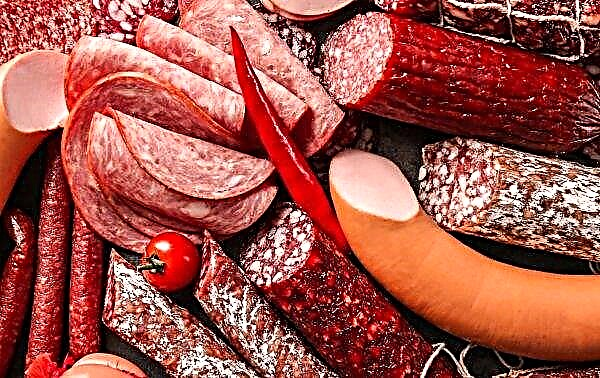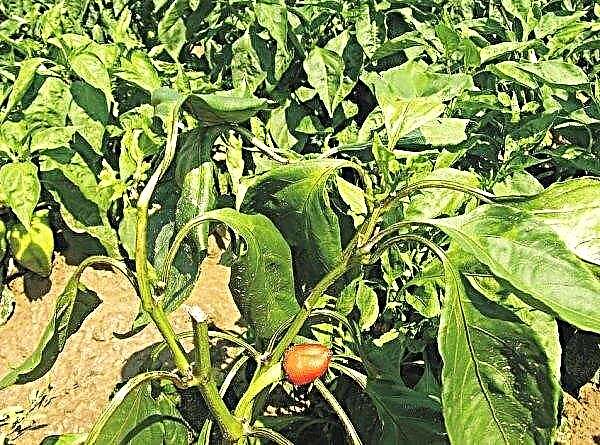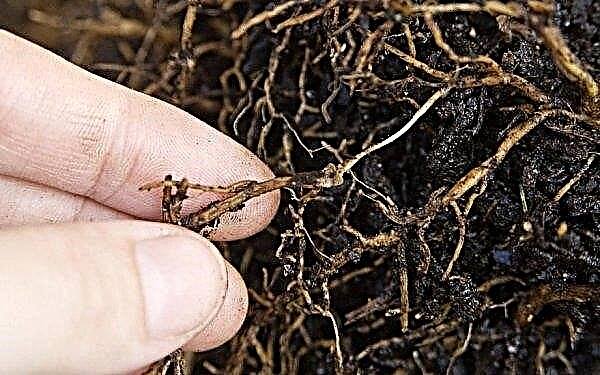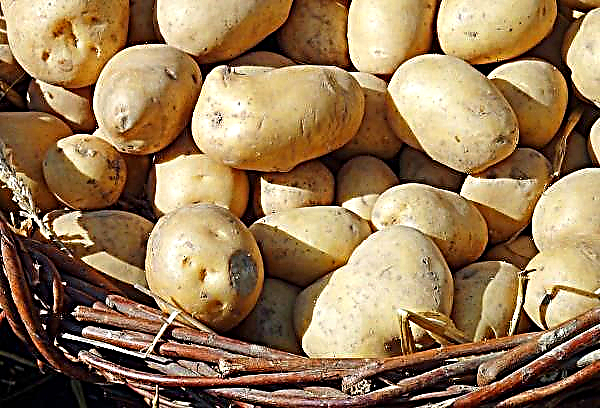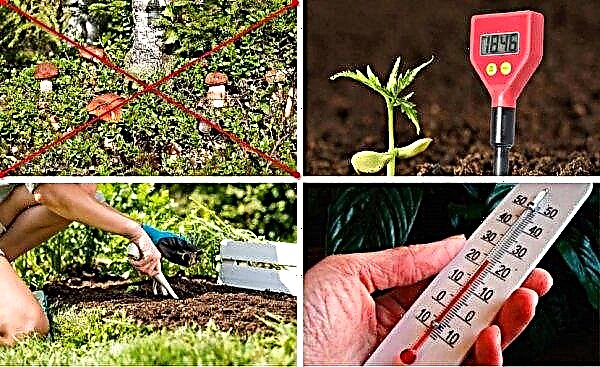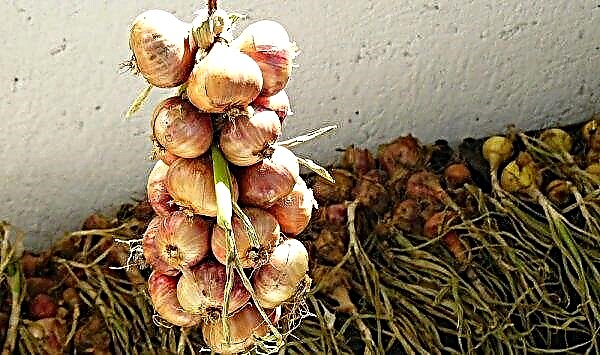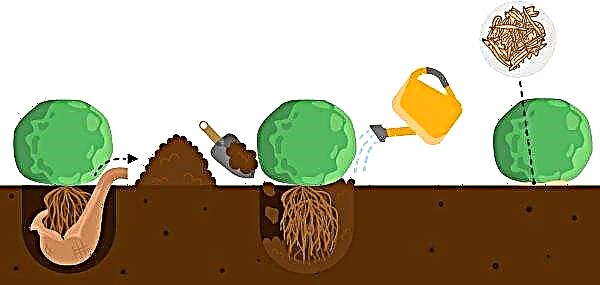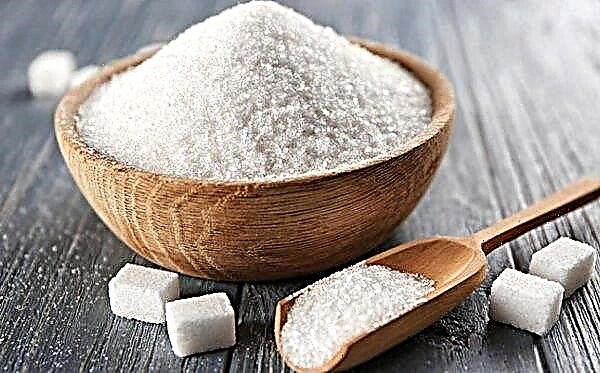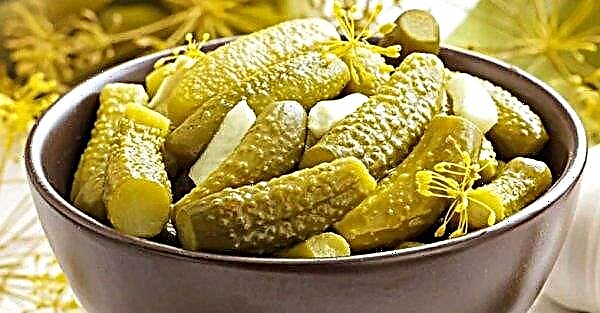Bell peppers are among the ten most popular garden plants. The article will discuss Gogoshara pepper, how to grow seedlings, what care, as well as protection from diseases and pests, is required for adult plants.
Description and characteristics of the variety
Gogoshara peppers are “fleshy” and juicy, the taste of pulp is sweet. Mistresses prefer this variety of pepper to other varieties, thanks to the thick wall of the seed chamber. In raw form, the fruits are used for the preparation of vitamin salads. First and second courses, side dishes, frosts and canned preparations for the winter are also prepared from pepper. The culture is grown in the southern and central regions.

Gogoshara pepper characteristic:
- mid-ripening (100-110 days), ripening in July-August;
- bush height - 35–40 cm;
- productivity - 3-5 kg per plant;
- moderately branched, leafy good;
- stems and leaves are dark green in color;
- depending on the variety, fruit color: red, yellow or orange;
- fetal weight from 50 to 130 g;
- wall thickness of the fruit chamber is 0.8–1.5 cm.
History of Variety Breeding
Gogoshary is not only a separate variety, but also the name of the sweet pepper variety type, which was obtained as a result of selection work at the Moldavian Research Institute. This group includes the popular varieties: Kolobok, Alyonka, Sunny, Ratunda.
Important! Gogoshary variety is easily pollinated with other varieties of pepper, including bitter. If sweet Bulgarian and burning chili peppers are planted nearby, the harvest of bell peppers will acquire a bitter taste.
Description of the bushes
Gogoshary have low and not too sprawling bushes. Thanks to this, the variety can be cultivated in a thickened planting, which saves the size of the beds and increases the yield from 1 m². Also, the advantages of a low bush is that Gogoshary can be grown without installing additional support (peg, trellis). This facilitates the time-consuming process of growing crops.
Description of the fetus
Gogoshary have a rounded (like an apple) or slightly flattened fruit with a small seed chamber and a thick fruit wall (0.8–1.5 cm).  The peel and pulp of the fruit can be red, orange or yellow. The fruit mass is from 50 to 130 grams, the pulp is sweet, crispy, the wall is thick. Productivity is high - from 3 to 5 kg per plant.
The peel and pulp of the fruit can be red, orange or yellow. The fruit mass is from 50 to 130 grams, the pulp is sweet, crispy, the wall is thick. Productivity is high - from 3 to 5 kg per plant.
Pros and cons of the variety
Peppers belonging to the Gogoshara sortotype have both undeniable advantages and disadvantages.
- Advantages:
- high productivity;
- thick-walled and heavy fruits;
- great taste;
- plucked unripe, able to ripen gradually;
- suitable for canning and freezing;
- perfectly transported over long distances;
- have a high content of vitamin C and low calorie content.
Did you know? Sweet pepper is a source of vitamins A and C. It also contains fiber, potassium, folate and iron.
- Disadvantages:
- fragile stalk;
- instability to solanaceous diseases;
- due to the small seed chamber unsuitable for stuffing (in cooking);
- the need for regular watering and mandatory protection against aphids and scoops.
The rules for growing varieties
Peppers are usually grown through seedlings, otherwise the plants do not have time to produce the whole crop before the cold weather. Also, when growing Gogoshar, you should adhere to the recommended planting patterns.

First option:
- four rows of plants are planted with a spacing of 40 cm;
- the distance between plants in a row is 25-30 cm;
- four rows of landings provide for a track 60 cm wide.
The second option:
- plant two rows of plants with a row spacing of 50 cm;
- two peppers are planted in one well;
- the distance between the holes in a row is 55-60 cm;
- every two rows of landings, a track of 50 cm wide is laid.
Seed selection and processing
Experienced gardeners, before starting sowing or soaking, calibrate the seeds in salted water. To do this, 1 tablespoon of salt (with a slide) is dissolved in one liter of water, after which the seeds are poured out and the solution is shaken.
High-quality, full-fledged seeds sink to the bottom of the tank, and semi-empty, low-quality seeds will float on the surface of the water. Floating seeds are drained along with the solution; only those that remain at the bottom are used for sowing.
Seeds are sown to a depth of 1 cm for 6-10 weeks before the expected date of planting in a permanent place. Two seeds are planted in each cell of the pallets or a separate pot. After two real leaves appear on the sprouts, one of them (the weakest) is carefully removed.
Two seeds are a guarantee that in case of non-viable seed, the pot will not remain empty. When removing the extra seedling, it is by no means pulled out with the root, but carefully cut with the help of nail scissors at the very surface of the earth.
Before sowing, seeds can be soaked in wet tissue for swelling and germination. So that the tissue bundle with seeds does not dry, it is placed in a plastic bag and tightly closed.
The best temperature for germination is +25 ... + 28 ° C. Since most homes are not so warm, it is better to place germinating seeds on a kitchen cabinet (the warmest zone) until sprouts appear.
Important! Germinating seeds can take up to 4 weeks. In a hot room, sprouts will appear in 7-10 days. Germination depends on the age of the seeds and air temperature.
Preparing land for seedlings
The soil can be purchased at a garden store or mixed independently. To do this, take 1/3 of meadow soil, 1/3 of compost from cattle manure and 1/3 of coarse river sand.
Pepper needs sandy soil, and sand also provides drainage. The finished soil mixture is poured into containers for growing. It is not necessary to fill the containers to the top, it is advisable to leave a space (0.5–0.8 mm) for easy watering.
Common planting boxes for growing peppers are not suitable. This is due to the fact that pepper does not like transplants, if you disturb its root system, it freezes for a long time in growth. Plastic pallets, peat pills or peat moss pots are well suited for growing.
Pallets are especially good in that they come with a drip tray and a transparent cover with which you can create a "microparnik" for seedlings. In such a greenhouse, the soil remains wet longer and the air temperature high.
After the first seedlings appear, the transparent cover is removed from the nursery for ventilation once a day for 30 minutes. Unfortunately, the soil is often infected with bacteria and pests, so before using the substrate for growing seedlings, it is advisable to decontaminate it.
Did you know? Despite the similarity in name, sweet pepper is not associated with a plant producing a popular kitchen seasoning. —black peppercorns.
Disinfection is carried out in several ways:
- Steaming The soil is abundantly watered with boiling water, allowed to cool and drain excess water, after which it is used for growing seedlings.
- Watering with a solution of water and manganese. This is an old but effective way. A manganese particle is dissolved in warm water, after which the color of the water becomes dark pink. This antiseptic solution is watered the soil a day before the start of sowing work.
- Annealing in the oven. The substrate is scattered on the baking sheet of the oven in an even layer, with a thickness of not more than 10 cm, after which it is installed in the oven and heated at a temperature of + 30 ° C for 20 minutes. After the soil has cooled, you can sow pepper in it.
Seedling Care
It is important to properly care for the pepper, provide it with timely watering and good lighting.
- Lighting. Containers with growing peppers are placed on a warm and sunny window sill or on a special seedling table equipped with a lamp to illuminate seedlings. Pepper needs at least 6 hours of sunlight per day, the optimal daily lighting time is 10 hours.
- Top dressing. If seedlings grow slowly, look frail and pale, crops are fed with mineral fertilizers for vegetable crops. Top dressing is diluted with water in the proportions indicated on the factory packaging, after which it is added to the root zone of seedlings. Root top dressing is combined with the next watering.
- Temperature condition. The room where the pepper seedlings are located should be warm. A temperature drop below + 16 ° C is unacceptable, as well as a rise above + 25 ° C. The optimum temperature for seedlings is +22 ... + 25 ° C.
- The disease. The most dangerous period for young pepper seedlings is the first month of life, since at that time it is vulnerable to such a fungal disease as the "black leg". This disease is dangerous because after the appearance of the first signs, within a day, the disease can destroy all seedlings. The disease causes too low a room temperature and waterlogged, wet soil.
At this time, it is advisable to adhere to minimal watering. The need for irrigation is determined by the dried up topsoil in seedlings, then moderate watering with warm water is carried out, exclusively under the root. After watering, the leaves of the seedlings should remain as dry as possible.
If the "black leg" nevertheless appeared on individual plants, urgent measures must be taken: the soil and seedlings are densely sprinkled with wood ash or treated with special antifungal drugs Fitoftorin-M or Trichodermin, while completely refusing to moisten the soil for the longest possible time .
Important! As the seedlings grow taller and older, acquire additional leaves, the danger of the "black leg" recedes, and irrigation is carried out more often, up to three times a week.
Transplanting seedlings into the ground
Pepper seedlings are ready for planting in open ground in 2–2.5 months after sowing. Usually by this time the plant has a thick stem 15-30 cm tall, 7-8 well-developed leaves, and sometimes flowers. At the time of pepper planting in open ground, the outdoor air temperature should not fall below +18 ... + 20 ° C.
Features of care after planting seedlings in the ground
The gardener will get a good harvest of pepper if he adheres to the cultivation agricultural technique: timely cultivation, hilling, irrigation, fertilizer and protection from diseases and pests.
The culture has high lighting requirements, in sunny summer, productivity increases significantly, and in cloudy and rainy - falls. This crop will not bear fruit well in the shade or partial shade, so it is undesirable to place beds of pepper near trees.
Watering and feeding
You can not get a high yield of pepper without abundant irrigation. Regular watering develops a powerful root system and a developed bush on which large and shaped peppers grow.
In the period from planting seedlings to flowering, watering is carried out every 10-12 days, in the following months of vegetation, especially in July-August, irrigation is carried out once a week, pouring 2-3 liters of water under each plant. The main irrigation methods are drip irrigation or sprinkling.
In heat and drought, the influx of nutrients to the leaves decreases, the leaves lose their turgor, wither and wither. At low humidity, accompanied by a long period of high temperature of air and soil, shedding of color and the termination of fruiting are observed.
In such cases, the best effect is achieved by sprinkling pepper on a leaf. This raises the air humidity around plants to 60–70%, the air and soil are cooled, and pepper leaves restore turgor and photosynthetic activity. Twice a season, pepper bushes are fed with liquid fertilizer. There are many options for liquid top dressing.
Twice a season, pepper bushes are fed with liquid fertilizer. There are many options for liquid top dressing.
Here are the fastest:
- On bird droppings. Half a bucket of bird droppings (dry or fresh) is poured to the top with water, mixed well, after which the container is tightly closed with a lid so that nitrogen does not evaporate, and left in a sunny place for fermentation for a week. The contents of the bucket are mixed daily with a wooden stick. After 7 days, concentrated dressing is ready. Use it with caution, always observing the proportion, since too much concentration of fertilizer can burn the roots of pepper. 0.5 l of concentrated fertilizer is added to a 10-liter bucket of clean water, stirred and poured under the bushes. At least 2 liters of diluted fertilizer are poured under one bush.
- On the nettle. Mowed nettles are placed in a plastic or iron barrel so that its amount occupies half the volume, after which they fill the tank with water to the top and close the lid. An indispensable condition, a barrel of water and nettles should be installed in a sunny, sheltered from the wind. Once a day, the contents of the barrel are mixed with a long wooden stick, releasing carbon dioxide from the mixture. After 10 days of fermentation, the fertilizer is ready, before use it must be diluted with water in a ratio of 1:10 (10 liters of pure water per liter of herbal slurry). 1.5–2 liters of top dressing is added under each plant.
Important! Liquid concentrated top dressings are convenient in that they can be used for a long time, using as needed. In addition, it is important that in liquid form, nitrogen fertilizing quickly enters directly to the root system of pepper.
Hilling and loosening the soil
After planting adult seedlings in open ground, Gogoshary must be regularly loosened in the root zone, saturating the soil with oxygen, while destroying weeds in the aisles. The first weeding is carried out 12-15 days after disembarkation, the second - another two weeks later.
The second weeding is combined with hilling bushes. Hilling is necessary for the formation of additional roots, the more roots a plant has, the stronger it is and will be able to bear fruit better. Hilling will also serve as an additional support for the bush during fruiting, when the poured fruits pull the crown of the plant to the soil.
All subsequent weeding is done as needed, as soon as small weeds appear in the rows between rows. During further loosening of the soil, it is important for the gardener not to destroy the hill of soil with which pepper has been earthed.
Formation and care of pepper bushes
As plants grow, they need additional shaping and adjustment of the load of the crop. In botany there is an unshakable law - the larger the number of fruits on plants, the smaller their mass. If the gardener wants to grow large peppers, you need to reduce the number of ovaries per bush.
This can be done by removing late flowers or extra small peppers, cutting them off with a garden pruner. In the first ten days of August, it is recommended to completely remove the flowers that are formed, since such a crop will not have time to ripen before the cold, and will weaken the strength of the bush.
In July, sultry and dry days are frequent when the air temperature reaches +28 ... + 30 ° C. At this temperature, the flowers of Gogoshar become sterile, they do not form fruits. To help pepper beds, gardeners sprinkle white spanbond (agrofiber) on top of the plants, shading and cooling the plants.
Another way to reduce the temperature on pepper plantings is to “whitewash” them. Vegetable growers densely spray plants on the leaf and fruits with a solution of water and chalk. Cretaceous white plants heat less in the sun, moreover, this is a good calcium supplement for pepper. Over time, the whitewash is washed away by dew and rains.
Did you know? Sweet and bitter peppers belong to the solanaceous family, they are close relatives of tomatoes, potatoes, eggplant and even tobacco.
Diseases and Pests
Peppers have their own pests and diseases, and you can get a good harvest of high-quality fruits only by protecting them from planting.
Common diseases:
- Cucumber or tobacco mosaic. Bushes infected with these diseases lag behind healthy plants by almost 50%. The internodes and branches of the plant become short, the leaves become small, with a mosaic deformed surface (healthy green tissue with a sick black-green or yellow), the fruits are small and deformed. Viruses are found in perennial and annual weeds, and are also transmitted by several species of aphids. Prevention: carry out disinfecting treatment of seeds before sowing and disinfect the substrate in the nursery, isolate from other solanaceous crops, fight weeds, apply insecticides.
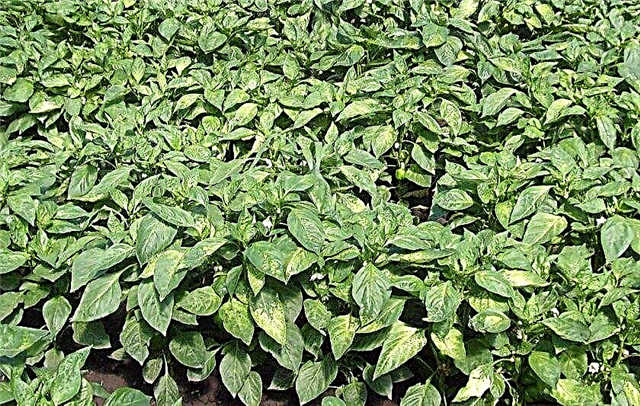
- Spotted wilting (bronze). The disease causes the virus, resulting in bronze color on young leaves and stems. With the development of the disease, brown, yellow or dark green rings appear on the plant. In the future, the disease causes necrosis of damaged tissues. Sick plants are much lower than healthy ones, few fruits are tied to them. The virus develops on weeds and solanaceous crops, and is transferred to peppers by pests. Prevention: the destruction of weeds around the site, the treatment of plantings with insecticides, the cultivation of resistant varieties.

- Column, or phytoplasmosis. The disease is dangerous for all plants in the nightshade family. In diseased plants, the leaves become discolored, the bush slows down in growth, the flowers remain sterile or form small deformed fruits that turn red early. Infected seeds are not a source of infection. The disease is spread by aphids, thrips and ticks. All varieties and varieties of pepper are not resistant to column. Prevention: removal of infected plants from the garden, treatment with insecticides.

- Bacterial spotting. The disease is caused by the bacteria Xanthomonas campestris. Signs of the disease: the appearance of numerous black spots on the leaves, subsequently they merge and the leaves die off. On stems, the disease causes longitudinal cracks. Fruits on such plants have rounded wet spots. In wet weather, bacteria from the wound spread to the seeds and enter the soil. Bacteria also winter on plant debris, ensuring the further spread of bacteriosis. Prevention: the use of healthy seeds, the cultivation of resistant varieties; crop rotation, treatment with copper-based fungicides (do not carry out two consecutive treatments with the same drug).
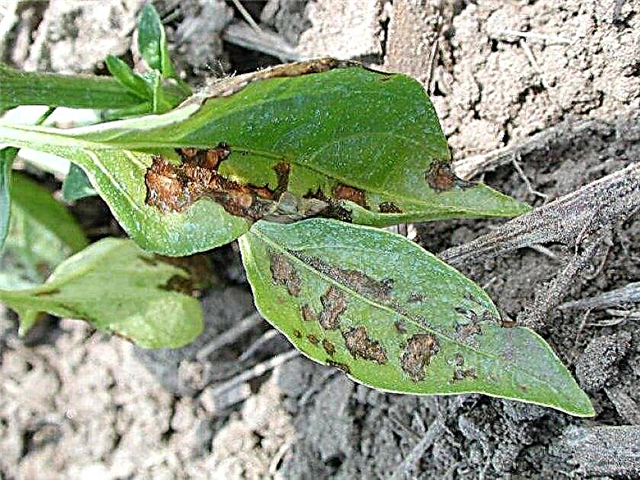
- Gray rot of pepper. A fungal disease that develops rapidly in the rainy season at temperatures below + 20 ° C. Rotting begins with young stems and leaves; on the fruit the disease looks like brown, wet spots. In conditions of high humidity, a gray coating appears on the surface of the spots. Prevention: soil disinfection (thermal or chemical), root irrigation, treatment with Bravo 500 SC, Ortiva 250 SC, Rovral 500 SC.
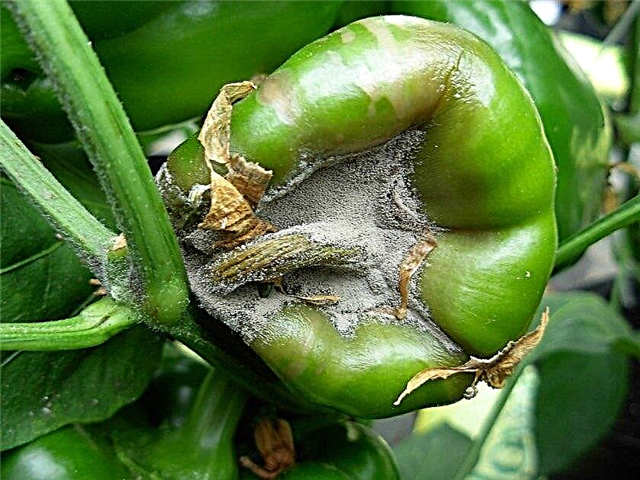
- Late blight. The disease is caused by spores of the Phytophthora infestans fungus, brown spots appear on the tissues of the infected plant, which increase in size over time. Brown or gray moist rounded lesion zones appear on the fruits. Without treatment, the plants die. Prevention: crop rotation, non-irrigation, fungicide treatment.
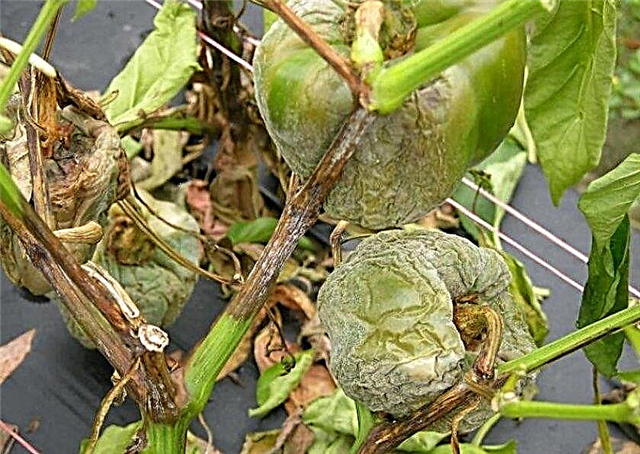
Pests of culture:
- Aphid. Small insects, with a body length of up to 1.5 mm, occupy the leaves, flowers and stems of plants. They feed on juice, as a result of which the leaves of the plants dry, flowers fall and ugly fruits appear. To get rid of aphids, plants are treated with insecticides "Karate", "Karbofos". Sometimes gardeners use biological control agents, such as nettle infusion or ash tincture with the addition of laundry soap (a glass of ash + 1 tablespoon of grated laundry soap + a bucket of water).
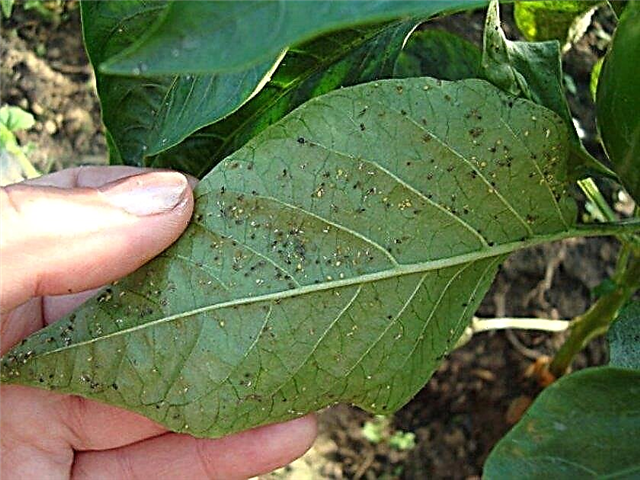
- Spider mite. The insect is so small that it is difficult for a person to notice it with the naked eye. The presence of a tick on plants produces a weightless web on leaves and stems. The spider mite is destroyed by spraying the preparations “Actellik”, “Karbofos”, “Fosbetsid”, “Fufanon”.
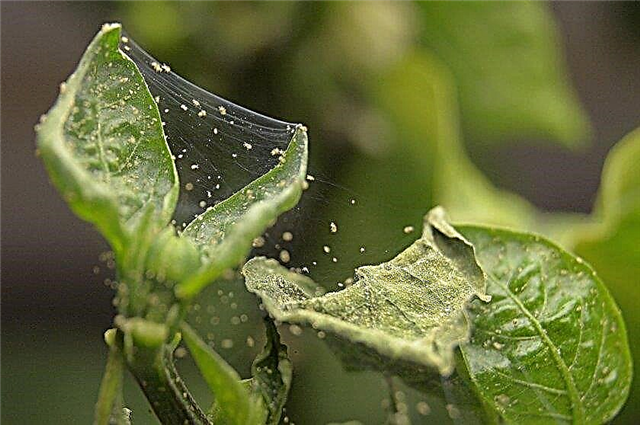
- Slug. They feed on leaves and fruits of vegetables, as a result of which decay occurs in places of damage. As a biological means of combating slugs, the soil of the beds is sprinkled with mustard powder or dry lime, which irritate the body of the pest.

- Wireworm. Small worms with a hard yellow chitin body. It harms the root system and stalks of pepper. In small areas, steaming of the soil is destroyed (the soil is well shed with boiling water). Also in the spring, in the pits in the infected area, you can put out the poison bait (20 days before the start of planting). The pests gathered on the bait are collected and destroyed every two to three days. The bait is purchased in garden stores ready-made.

Harvesting and storage
Technical ripeness in the first fruits of Gogoshar occurs in the middle or end of July. Fruiting lasts until the end of August. As the fruit stains, they must be removed from the bush. Ripe peppers on the plant delay the formation and ripening of the remaining fruits, which ultimately reduces the overall yield.
The collected fruits of bell pepper are stored in a dry and cool place for up to 30 days. If necessary, you can postpone the biological maturation of pepper, for example, before transporting over long distances.Did you know? Since pepper fruits have seeds, and they are flowering plants - biologically pepper refers to fruits, not vegetables.
In this case, the fruits of Gogoshar that have reached the desired size are removed from the bush, and carefully placed in cardboard boxes with holes for ventilation. After a few weeks, the green flesh of the pepper acquires the characteristic red or yellow color.

Sweet pepper culture is not very demanding on growing conditions, but still a good crop can only be obtained on fertilized and irrigated beds. Peppers also require timely protection against diseases and insect pests.











